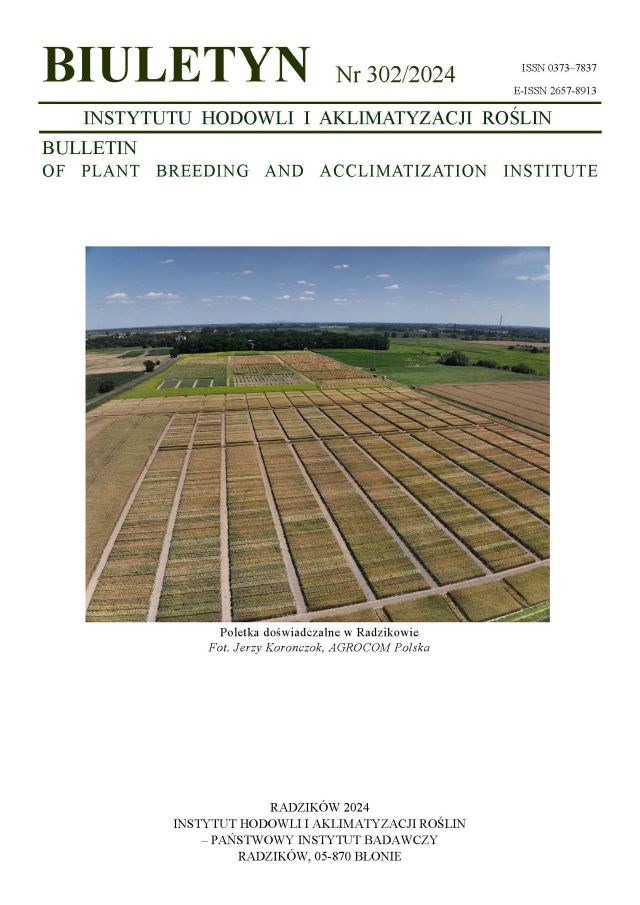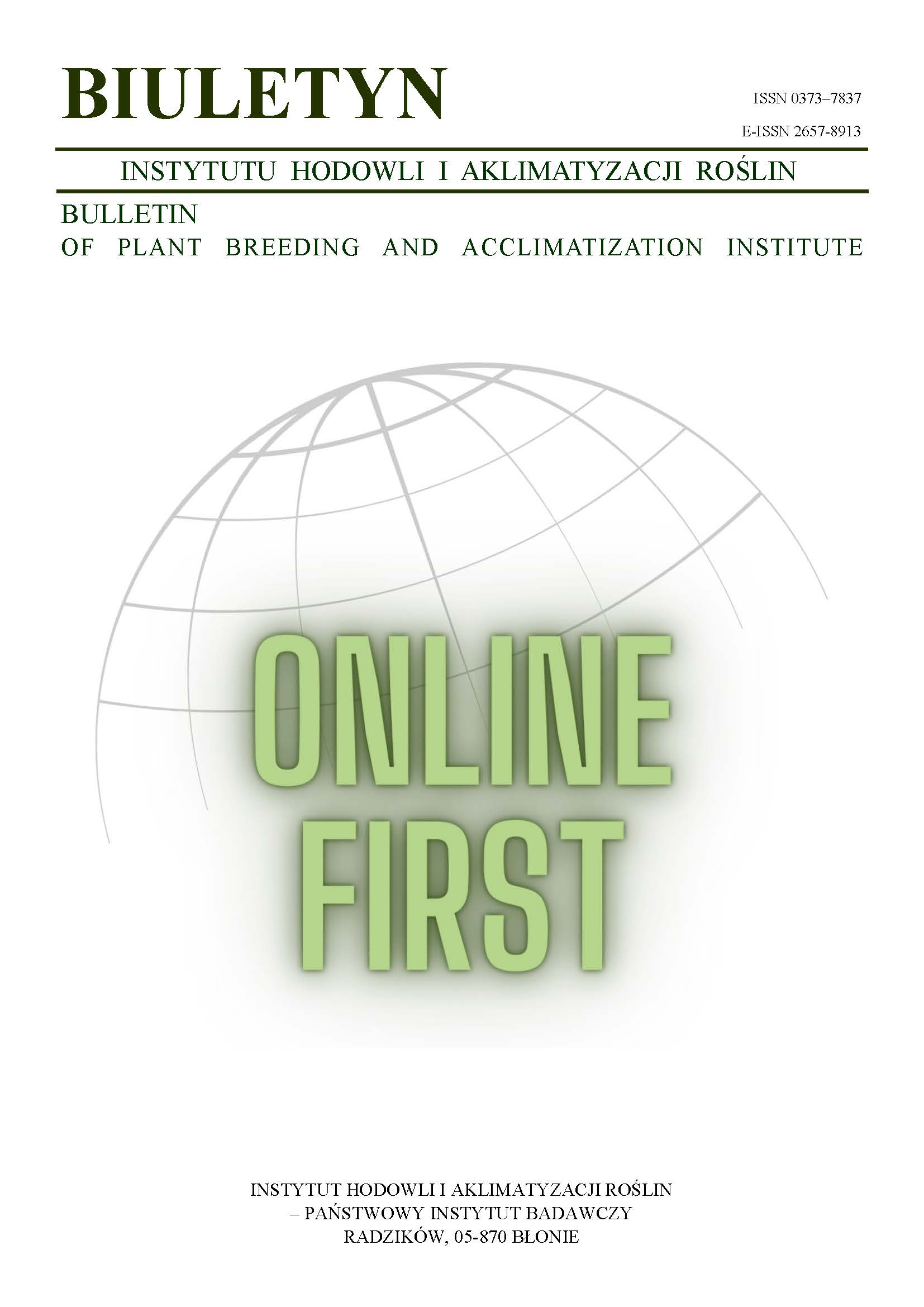Estimation of breeding values of inbred lines of maize
Władysław Kadłubiec
kghrin@upwr.edu.plKatedra Hodowli Roślin i Nasiennictwa, Akademia Rolnicza we Wrocławiu (Poland)
Rafał Kuriata
Katedra Hodowli Roślin i Nasiennictwa, Akademia Rolnicza we Wrocławiu (Poland)
Cecylia Karwowska
Hodowla Roślin Rolniczych „Nasiona Kobierzyc” (Poland)
Zbigniew Kurczych
Hodowla Roślin Rolniczych „Nasiona Kobierzyc” (Poland)
Abstract
The offspring of 6 maternal dent form lines (1566-5, 1573-2,1581-11, 1581-7, 1585-4, 1591-2) crossed with 8 testers (K182, K188, K194, K231, K296, K324, K376, S335) were investigated. The experiments were carried out at two locations (Kobierzyce and Smolice) with two replications using incomplete block design. Data were recorded for grain yield, dry matter content, lodging before harvest, tillering and smutted plants. Analyses of general and specific combining ability were done. Significant differences between environments for all studied traits were found. The interaction between GCA effect and environment was insignificant for grain yield, which is the valuable information for breeders. Insignificant interaction SCA effects with environment were shown for grain yield.
Keywords:
combining ability, hybrid, maize, yieldReferences
Bilski E., Siódmiak J., Heimann H. 1997. Wartość gospodarcza mieszańców kukurydzy zarejestrowanych i uprawianych w Polsce w latach 1972–1996. Zesz. Probl. Post. Nauk Rol. 450: 31 — 54.
Google Scholar
Griffing B. 1956. Concept of general and specific combining ability in relation to diallel crossing system. Austr. J. Biol. Sci. 9: 463 — 492.
DOI: https://doi.org/10.1071/BI9560463
Google Scholar
Królikowski Z. 1973. Szacowanie ogólnej i swoistej wartości kombinacyjnej linii wsobnych kukurydzy krzyżowanych w układzie diallelicznym. Biul. IHAR 3 (4): 39 — 47.
Google Scholar
Piovarci A. 1975. Genetic analysis and combining ability of grain yield components of maize inbred lines. Genetika a Slechteni 1 (1): 3 — 8.
Google Scholar
Troyer Forrest A. 1999. Background of U.S. hybrid corn. Crop Sci. 39: 601 — 626.
DOI: https://doi.org/10.2135/cropsci1999.0011183X003900020001xa
Google Scholar
Authors
Władysław Kadłubieckghrin@upwr.edu.pl
Katedra Hodowli Roślin i Nasiennictwa, Akademia Rolnicza we Wrocławiu Poland
Authors
Rafał KuriataKatedra Hodowli Roślin i Nasiennictwa, Akademia Rolnicza we Wrocławiu Poland
Authors
Cecylia KarwowskaHodowla Roślin Rolniczych „Nasiona Kobierzyc” Poland
Authors
Zbigniew KurczychHodowla Roślin Rolniczych „Nasiona Kobierzyc” Poland
Statistics
Abstract views: 23PDF downloads: 7
License
Copyright (c) 2006 Władysław Kadłubiec, Rafał Kuriata, Cecylia Karwowska, Zbigniew Kurczych

This work is licensed under a Creative Commons Attribution-ShareAlike 4.0 International License.
Upon submitting the article, the Authors grant the Publisher a non-exclusive and free license to use the article for an indefinite period of time throughout the world in the following fields of use:
- Production and reproduction of copies of the article using a specific technique, including printing and digital technology.
- Placing on the market, lending or renting the original or copies of the article.
- Public performance, exhibition, display, reproduction, broadcasting and re-broadcasting, as well as making the article publicly available in such a way that everyone can access it at a place and time of their choice.
- Including the article in a collective work.
- Uploading an article in electronic form to electronic platforms or otherwise introducing an article in electronic form to the Internet or other network.
- Dissemination of the article in electronic form on the Internet or other network, in collective work as well as independently.
- Making the article available in an electronic version in such a way that everyone can access it at a place and time of their choice, in particular via the Internet.
Authors by sending a request for publication:
- They consent to the publication of the article in the journal,
- They agree to give the publication a DOI (Digital Object Identifier),
- They undertake to comply with the publishing house's code of ethics in accordance with the guidelines of the Committee on Publication Ethics (COPE), (http://ihar.edu.pl/biblioteka_i_wydawnictwa.php),
- They consent to the articles being made available in electronic form under the CC BY-SA 4.0 license, in open access,
- They agree to send article metadata to commercial and non-commercial journal indexing databases.
Most read articles by the same author(s)
- Sylwia Lewandowska, Rafał Kuriata, Władysław Kadłubiec, Morphological and genetic diversity of maize inbred lines , Bulletin of Plant Breeding and Acclimatization Institute: No. 264 (2012): Regular issue
- Krzysztof Wójcik, Rafał Kuriata, Sylwia Lewandowska, Heritability and relationships between maize agricultural traits , Bulletin of Plant Breeding and Acclimatization Institute: No. 264 (2012): Regular issue
- Wanda Kociuba, Zbigniew Segit, Władysław Kadłubiec, Rafał Kuriata, Estimation of combining ability of chosen T. durum Desf. cultivars and lines , Bulletin of Plant Breeding and Acclimatization Institute: No. 264 (2012): Regular issue
- Sylwia Lewandowska, Rafał Kuriata, Władysław Kadłubiec, Breeding value of selected maize inbred lines , Bulletin of Plant Breeding and Acclimatization Institute: No. 264 (2012): Regular issue
- Władysław Kadłubiec, Rafał Kuriata, Jarosław Bojarczuk, Estimation of variability and interrelationships among various traits in durum wheat lines , Bulletin of Plant Breeding and Acclimatization Institute: No. 249 (2008): Regular issue
- Henryk Bujak, Stanisław Jedyński, Jan Kaczmarek, Cecylia Karwowska, Zbigniew Kurczych, Józef Adamaczyk, Evaluation of breeding value of inbred lines of maize on the basis of multitrait analysis , Bulletin of Plant Breeding and Acclimatization Institute: No. 240/241 (2006): Regular issue
- Tomáš Vyhnánek , Jan Bednář , Władysław Kadłubiec, Polymorphism of grain storage proteins in triticale varieties registred in the Czech Republic , Bulletin of Plant Breeding and Acclimatization Institute: No. 240/241 (2006): Regular issue
- Elżbieta Czembor, Roman Warzecha, Józef Adamaczyk, Zbigniew Kurczych, Pre-breeding of maize with improved resistance to ear rot and stalk rot , Bulletin of Plant Breeding and Acclimatization Institute: No. 236 (2005): Regular issue
- Władysław Kadłubiec, Rafał Kuriata, Cecylia Karwowska, Zbigniew Kurczych, Estimation of combining ability of inbred lines of maize (Zea mays L.) , Bulletin of Plant Breeding and Acclimatization Institute: No. 240/241 (2006): Regular issue
- Władysław Kadłubiec, Rafał Kuriata, Multiple analyses of traits determining grain yield of inbred lines and hybrids F1 of maize , Bulletin of Plant Breeding and Acclimatization Institute: No. 231 (2004): Regular issue














